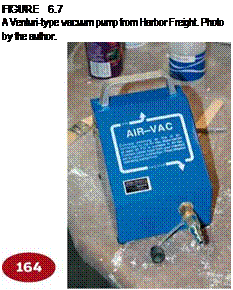Because silicone is relatively viscous as a liquid (compared to water), air bubbles easily become suspended in it when the components are mixed together. For that reason, it is often recommended that silicone be de-aired or degassed in a vacuum chamber before it goes into the mold. This might not always be possible for a couple of reasons: You don’t have access to a vacuum chamber or a vacuum pump or there isn’t enough time because the silicone has a very short pot life before it kicks.

![]()
If you mix the silicone components carefully it is possible (possible does not mean likely) to prevent air bubbles from occurring. It is likely that you can minimize the size and number, but you are not likely to prevent bubbles altogether. There is also an effective workaround for de-airing your silicone without investing in an expensive vacuum pump and vacuum chamber. You can eliminate air bubbles (or at least make them very, very small—almost invisible) by pressurizing the silicone instead of pulling a vacuum. You still need a pressure chamber to do it, but air compressors are far less expensive than vacuum pumps and you probably already have access to an air compressor.
Small vacuum/pressure chambers can be found rather easily online at little cost, and if you’re dead-set on vacuum de-airing, for about $18(£9.66) from Harbor Freight you can buy a Central Pneumatic air-vac, a Venturi-type vacuum pump that uses air pressure to create enough vacuum to de-air your silicone in short order!
Your air compressor needs to generate at least 90 lbs. of pressure to pull 28.3 (71.9 cm) inches of mercury at sea level. From the same vendor you can also find a 2%-gallon pressure paint tank that is great for pressure or vacuum for under $100 (£53.59). Problem solved. With a little more effort you can replace the opaque metal lid with a clear Plexiglas (3/4-1 inch thick or 2-2.5 cm) replacement so you can see what’s going on inside. Often, however, simply allowing the silicone to sit at room temperature until the air bubbles have risen to the surface and disappeared is all you need to do before pouring or injecting the silicone into the mold cavity provided the silicone is not fast-setting.
